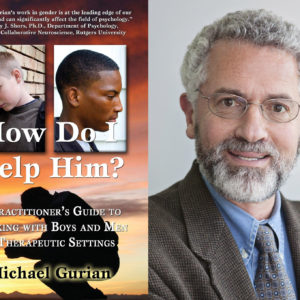Product Description
We are proud to be able to offer you six (6) hours of video content that cover the research-based Gurian philosophy and our science-based strategies for raising boys and girls most effectively. Get ready to learn and apply practical applications that have been proven successful in homes and and communities around the world!
Please reach out to our team as needed at info@gurianinstitute.com.
Each video session is packed with actionable information and can be accessed via your computer, I device, Smart phone or other similar technology.
Unit 1
2 Sessions totaling approximately 40 Minutes
Session 1: A Small Thing Makes A Big Difference; The Brain Science Approach to Parenting; Nurture, Nature, and Culture;The Human Genome and Your Children’s Genes; 8 Key Questions You Might Be Asking, and Answers Based in Science.
Session 2: 10 Key Questions and Answers Regarding Boys and Girls; Girls and Drama, Boys and Screen Time; School Issues That Boys Especially Face; Protecting Kids from Violence–at the Source; Helping Shy Kids; Gross Boy Play; Tantrums and Anger; ADD/ADHD.
Unit 2
7 Sessions, Approximately 100 Minutes
Session 3: Male and Female Brains, Different but Equal; How to Set Up Boy and Girl Friendly Family Systems; Four Aspects of Male/Female; Transgender and the Gender Spectrum; Bridge Brains (1 in 5 exceptions).
Session 4: X/Y Chromosomes and Brain Scans; Science is not a Stereotype; Neuro-plasticity; A First Glance at Brain Differences; How to Study Your Kids’ Brains; Girls, Boys, and Verbal-Emotive Centers in the Brain; Why Is Our Society So Hard on Boys?
Session 5: Boys and Playtime; Different Male/Female Relating Styles; Words vs. Objects; Strategies for Early Literacy; Strategies for Helping Girls and Boys Throughout the Early Years; You Are a Citizen Scientist!
Session 6: Gene Testing for Medications; What To Do If Your Child May Have a Brain Disorder; Depression, Anxiety, ADD/ADHD, and Other Gene Based Issues; Rumination Loops in Girls; Attention and Focus in All Brains; Working with Boys and Anger.
Session 7: 46,000 Brain Scans; Boys and the Cerebellum; Strategies for Talking With Boys About Feelings; Helping Girls with ‘Multi-Tasking’ Stress; Smart Phones and Video Games; Strategies for Finding the Right Therapist; Features of the Female Brain; White and Gray Matter Activity in the Different Brains.
Session 8: Frontal Lobe Differences in Boys’ and Girls’ Brains that Affect Decision-making; Left/Right Hemisphere Differences; Different Mother/Father Styles of Showing Love; Boys, Girls, and Resilience-Building; Strategies to Help with Emotional Problem-Solving; How to Parent ‘Bi-Strategically.’
Session 9: How Emotional Pathways May Not Need Words; Use Your Words; Humor and the Brain; Boys’ Brains in a Boredom State; How Much Homework is Too Much; Strategies for Parenting Brains of Both Girls and Boys So That Their Assets Can Shine.
Unit 3
3 Sessions, Approximately 47 Minutes
Session 10: Boys, Girls, and Biochemistry; Oxytocin and Testosterone; Aggression and Empathy Nurturance; Father-Daughter Bonding and Communication; Mother-Son Bonding and Communication; Strategies for Healthy Conflict Resolution; Girl Drama–a Resilience Builder; Multi-Strategic Parenting; Teasing vs. Bullying.
Session 11: Girls and Self-Worth Development; Tips for Coaching Girls and Boys; Leadership Training in Healthy Pecking Orders and Hierarchies; Boys and Self-Worth Development; Healthy vs. Unhealthy Aggression; Strategies to Help Girls with Rumination and Drama; Can Children Express Themselves Too Much?
Session 12: Aggression is not Violence; Tips for Helping with Sibling Rivalry; Resilience-Building Strategies; Schools and Zero-Tolerance Policies; Homework Strategies; the Power of Tone of Voice; Strategies for Healthy Discipline Systems; Do We Misread Boys’ Signals?
Unit 4
3 Sessions, Approximately 38 Minutes
Session 13: More Strategies for Raising Girls and Boys; How to Protect your Children from Environmental Neuro-Toxins; the Danger of Endocrine Disruptors; Male Depression, Under-motivation, and Rage; Girls and Obesity; Addiction Genetics; the New Depression Spectrum; Protecting Children with Depression.
Session 14: Strategies to Help Manage Screen Time; Protecting Your Children’s Brains in a Digital Age; Dopamine and Social Media; the Danger of Instant Gratification; Passive vs. Active Brain Development; the Best Age to Give Kids a Smart Phone; Developmental Differences in Digital Brains; Screens and Techno-isolation.
Session 15: 10 Strategies for Keeping the Child’s Brain Active; 12 Strategies for Good Digital Health; Video Games and Potential Mental Health Issues; the Healthy Side to Gaming; Entertainment vs. Maturation; Developmental Strategies for Children in Early Childhood; Intervention vs. Non-Intervention; Discipline and Behavior Management; Girls, Spatial Development, and Science.
Unit 5
4 Sessions, Approximately 54 Minutes
Session 16: 7 Strategies for Ensuring Healthy Social-Emotional Development (SED) in Both Girls and Boys; Similar but Different Social-Emotional Journeys; the Biology of SED; Whining vs. Emotional Life; the Importance of Women and Men Teaching SED Differently; Can We Use “Use Your Words” Too Much?
Session 17: Healthy Attachment and Separation Strategies; When My Kids Lie; Communication Strategies that Work; Conflict Strategies that Work; Are Love and Respect the Same Thing? Using Debate as a Parenting Tool; Healthy Divorce; Signs of Mental Health Issues; Is ADHD Over-Diagnosed?
Session 18: 6 Strategies for Treating Child and Adolescent Depression; the Role of Hormones in Depression and Anxiety; Brain Scans of Children and Adults Who Have Experienced Trauma; Strategies for Healing Trauma.
Session 19: 7 Strategies for Helping Girls with Strong Social Emotional Development; 7 Strategies for Helping Boys with Strong Social Emotional Development; Working with Sensitive Boys and Sensitive Girls; How to Teach Both Empathy and Resilience.
Unit 6
4 Sessions, Approximately 53 Minutes
Session 20: Protecting the Educational and Emotional Lives of Boys; Myths About Masculinity; 3 Causes of Male Violence; Battling Our Society’s Abandonment of Healthy Male Development; How to Raise a Mature Man; Handling Boys’ Interrupting Behavior and Impulsiveness; 14 Strategies for Helping Boys Mature and Express Emotions.
Session 21: 10 Strategies for Motivating Boys; Dopamine, Video Games, and False Achievement; Competition in School; New Strategies for Communicating with Boys and Building Character; the Art of Manhood; Healthy Rites of Passage for 12 – 14 Year Old Boys; Using Faith Communities; Heroes in Boys’ Every Day Lives.
Session 22: Strategies for Building Self-Discipline, Independence, and a Sense of Purpose; How Girls and Boys Might Experience “Purpose” Differently; How to Use the Three Times Rule to Guide Boy Behavior; Peripatetic Counseling and Growth; Do Our Schools Don’t Understand Boy Energy?
Session 23: Strategies to Help Boys with School Work and Homework; Signs of Good Schools for Boys; 8 Strategies for Academic Success; Boys and Risk-Taking; 9 Learning Strategies We Hope Teachers Will Use; Vocational Education at 16; Does Every Boy in Your Life Have a Mentor?
Unit 7
4 Sessions, Approximately 47 Minutes
Session 24: Protecting the Emotional Lives of Girls and Building Strong Girl Leaders; the “Uncomfortable Challenge”; Empowerment, Resilience, and Strength; Strategies for Building Resilience in Girls; Strategies for Building Self-Esteem; Technology and Self-Esteem; Girls and Risk-Taking; Endocrinology and Girls’ Brain Biology as Girls Hit Adolescence; How Do We Help an Angry Girl?
Session 25: Girls Need Both Maternal and Paternal Nurturance; 6 Strategies for Building Your Own Nurturing Style; the Art of Mentoring Girls; Fears About our Daughters’ Fragility; Rites of Passage for Girls; Can We Say, “Great Job!” Too Much?
Session 26: Girls and STEM education; Girls and Math Fear; 7 Strategies for Helping Girls with Math; the Brain and Math; Math Training in Early Years; What to Do When She Says, “I’m Bad at Math!” Perfectionism in Girls; Girls, White Matter Activity in the Brain, Leadership and Success.
Session 27: Relational Violence and Bullying; 6 Strategies to Help a Bullied Girl; Girl Drama and Cyber-Bullying; the Wound is the Gold; Relational Aggression is not Necessarily Violence; “Picking at the Flaw”; 8 Strategies for Helping Girls with Drama and Relational Aggression; a Nature-Based Approach to Bullying; Celebrating both Science and Common Sense in the Art of Parenting.
Editor’s Note: As you take this course, you may notice that a few slides are missing from the PDF and other not used in the Power Point. The three missing slides have been removed from the PDF for copyright purposes. The extra slides have been retained in the PDF as bonus content.











Reviews
There are no reviews yet.